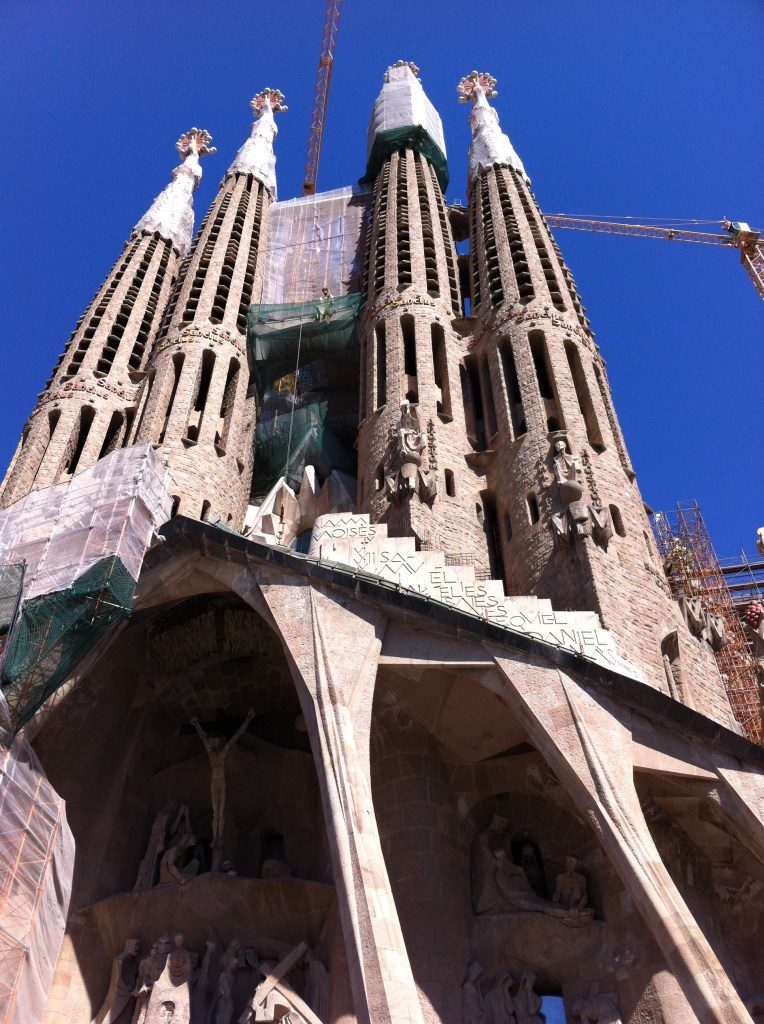This is a travelogue, part guide and part journal of three days in Barcelona. Very simply, it’s a stunningly beautiful city. You can walk in pretty much any direction and find yourself neck-deep in charm. Barcelona isn’t Catherine Deneuve beautiful; it’s Ingrid Bergman beautiful. There’s something graceful and unfussy about it and its people. Downtown on a weekday we saw far fewer neckties than in most large cities.
Those who have visited Spain might find this to be old news but Barcelona struck me as a wonderful mélange of Mexico (architecture), New Orleans (wrought-iron balconies, courtyards), the Caribbean (palm trees, beaches), Sydney (a comfortable marriage of old and new and a pristine, welcoming harborfront) and Paris (large 19th-century apartment buildings lining grand avenues, and cafes). Maybe this is what Havana was like sixty years ago, or Beirut, which is supposed to have been magnificent.
People in southeastern Spain consider themselves Catalan more than Spanish. Catalonian flags hang from many balconies and fly alongside (sometimes instead of) Spanish flags in front of office buildings. Signs are in Catalan and Spanish, in that order. There are a lot of x’s in Catalan.
People seem not only willing and able but eager to speak English. They know before the first hola that you’re English or American (of which there are plenty, as well as tourists – aggravating masses of them – from every corner of the world). The attitude toward language is clearly different here than in France, where the visitor is expected at least to make an effort first in French.
You quickly become accustomed, by the way, to saying “Bar-the-lona” and “Gra-thee-as.” It doesn’t sound silly when everyone around you is doing it.
Barcelona is clean but with much graffiti. The Metro is easy to navigate and gets you within a few blocks of anywhere. Like Paris, it’s a city of distinct neighborhoods. In our short visit we had time to explore only a few.
El Barri Gòtic is the oldest part of Barcelona, with many buildings dating to medieval times. A labyrinthine web of alleys and narrow, stone streets, el Gòtic is packed with shops, bars and restaurants, and attracts locals and tourists alike. La Seu, the largest of the city’s cathedrals, is here. It’s a magnificent bit of Gothic architecture and hides its age well. (Construction began in 1298.)



Nearby el Born, another small medieval quarter, is equally rich with places to shop, eat and drink but more upscale than the grittier Gòtic.
La Rambla is a street that begins at the waterfront and slopes upwards for over a mile. Either a bustling, colorful promenade or a tourist trap, depending on one’s outlook, it boasts too many cafes, restaurants, souvenir shops and street performers to count.
(TIP: Most cafes display their menus, with prices, in front. If they don’t, ask how much something is before you order. Calvin and I had seen folks enjoying a beer or sangria in the cool afternoon sunshine so we succumbed to one friendly young waiter’s greeting. “Hello! How about a sangria? A cervesa?” The drinks were big – no question about that – and the sangria was good, but it was a shock to receive the bill for 31 euros. That’s over forty dollars for a mug of beer and some sangria. Lesson learned.)

Flanking the yacht marina, Barceloneta bustles with activity. Endless rows of seafood restaurants look over the harbor. Waiters or owners stationed at entrances all hawk their goods. A hundred restaurants announce the best paella auténtica.
It can be a challenge to peruse a menu while being peppered with a rat-a-tat verbal pitch. The demure tourist might feel annoyed by the more assertive barkers. Sometimes a “No, gracias” works and sometimes it doesn’t.
Sagrada Familia, or Church of the Holy Family, is Barcelona’s best-known landmark. Construction began in 1882, Catalan architect Antonio Gaudi took over the project the next year, and it still is not finished. Scaffolding enshrouds it and multiple cranes tower over the steeples. I don’t know the language of architecture so can only describe this building as a surreal jumble of styles, shapes and colors. It’s for the viewer, and of course the worshiper, to decide whether it all works.



Barcelona delights in food generally but shellfish particularly. The romance extends beyond restaurants and kitchens to the realm of public art.
And ham. Whole hams hang from the ceilings of even the smallest, dumpiest cafes and bars. Nowhere have I seen such universal pride in meat. Many shops offer a dozen varieties of ham or more, from Serrano and Iberico up to the super-luxe Bellota, made from black pigs that feed on acorns. Bellota runs in the neighborhood of $100 per pound. I bought a tiny bit and found that it’s indeed like nothing else I’ve ever eaten. While many of us are familiar with Prosciutto and its delicate, salty rosiness, Bellota is a deep cherry color, approaching ebony. The meat is firm and chewy and resonant of those acorns. Ham like this spoils a person.
Just off La Rambla sits Mercat de Sant Josep de la Boqueria, a wild, exciting, aromatic food market. A stroll through la Boqueria is truly a sensual experience. Roughly 200 feet square, the aisles seem to extend endlessly through the teeming shoppers, browsers and culinary devotees. 20 or 30 stalls sell nothing but ham, another 20 or 30 poultry. There are shops devoted to meat, cured meat, organ meat, nuts, fruit (fresh, dried, candied), cheese, wine, candy, juice. Fresh seafood occupies the center of the market, where 15 or 20 merchants keep pretty displays of fish and shellfish. Food counters offer oysters, ham, sandwiches (entrepans), tapas, tacos and guacamole, wine and beer. The whole shebang is surrounded by cafes where one can fortify and take nourishment after a debilitating session of browsing.
Coming up – hotel and restaurant adventures and commentary.




